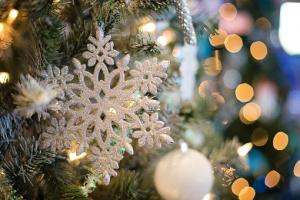-
About Homer
-
- Americans with Disabilities Act Compliance Program City Campgrounds Community Recreation Hickerson Memorial Cemetery
- Library Parks & Trails Public Safety Fire Police Emergency Information
- Events & Activities City Calendar Library Calendar Recreation Calendar Doing Business in Homer Sister City Program Coast Guard City
-
- Departments
- Government
- How Do I?
Tips for Sharing a Fire-Safe Holiday Season
The holidays present an increased risk of home fires--often involving cooking, Christmas trees, candles and decorations. Most of these home fires, though, can be prevented during the holidays and beyond.
Here are a few basic tips to make sure your holidays are happy and bright -- and not in the flashing-siren kind of way.
Cooking
Most home fires start in the kitchen, and most of those from unattended cooking. When simmering, baking or roasting your favorite holiday foods, remember to check it regularly. There are many great distractions during the holidays, so use a timer to remind yourself that you are cooking.
Lights
This is the time of year we like to bring a lot of light into our homes. Check your sets of lights to insure they have been tested by Underwriters Laboratories (UL) and that they don't have any broken or cracked sockets, frayed or bare wires, or loose connections. If damaged, discard them.
Do not connect more than three standard-size sets of lights per single extension cord, and always turn off Christmas lights before leaving the home or going to bed.
After the season, bring outdoor electrical lights inside to prevent hazards and make them last longer.
Christmas Trees
Special fire safety precautions need to be taken when keeping a live tree in the house. A burning tree can rapidly fill a room with fire and deadly gases.
Set your tree up away from heat sources (including fireplaces or heat vents) as the heat will dry out the tree, causing it to be more easily ignited by heat, flame or sparks. Add water to the tree stand and make sure to water the tree daily. A dry tree is dangerous because it catches fire easily. Check out this video link if you need convincing!
Check your Christmas tree lights as suggested above. According to the National Fire Protection Association, 1/3 electrical failures or malfunctions are a factor in 1/3rd of all Christmas tree fires.
Consider taking your tree down soon after the holiday. The National Fire Protection Association reports that half of home Christmas tree fires occur between December 22nd and January 5th. When disposing of your tree, never put tree branches or needles in a fireplace or wood-burning stove. It can result in a very large fire, throwing off dangerous sparks and embers and may result in a chimney fire. The same goes for holiday wrapping paper, believe it or not.
Candles
If you use candles for decorations, make sure they are in stable holders and place them where they cannot be easily knocked down. Be attentive; don't go to bed or leave the house with candles burning. And never put lit candles on a tree for decoration.
Smoke Alarms
Finally, as in every season, have working smoke alarms installed on every level of your home, test them monthly and keep them clean and equipped with fresh batteries. Know when and how to call for help. And remember to practice your home escape plan.
Here's to a safe and enjoyable holiday season!



